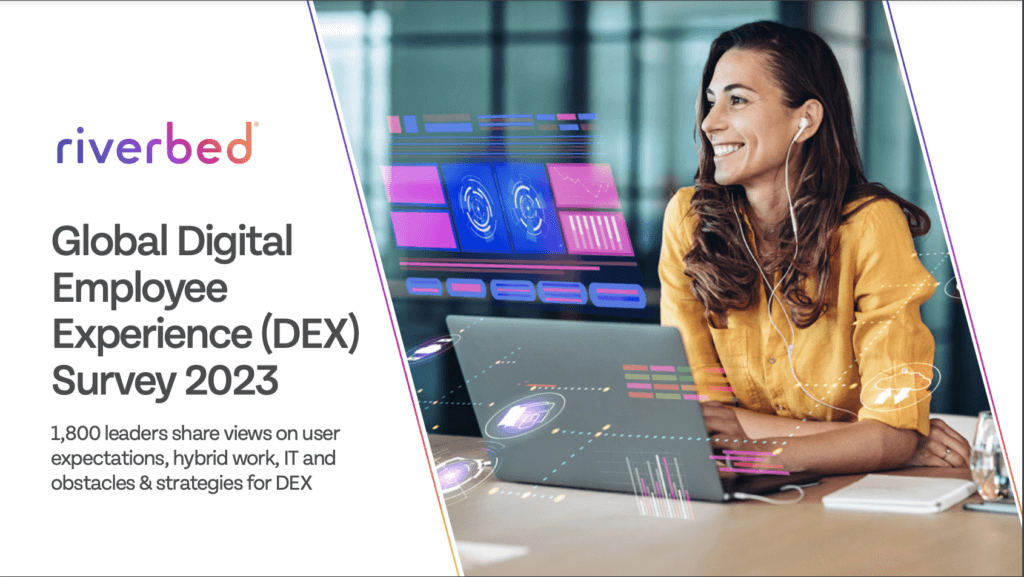
In the current landscape, delivering an excellent digital employee experience (DEX) is more important than ever. DEX plays a critical role in an organization’s day-to-day operations, and enterprises must invest in this area as a key business strategy. In fact, outdated technology, a driving factor of poor DEX, is costing American organizations over a trillion dollars in lost productivity.
While the case for improving an organization’s DEX is clear, it’s often an uphill battle. Digital infrastructures and tech stacks are more complex with hybrid workforces, combinations of cloud and on-prem services, and a mix of modern and legacy technology. Companies must also navigate the higher digital expectations of the next generation workforce. This shift has essentially led to chief information officers (CIOs) playing a key role in talent management and retention too, a reflection of the growing importance of IT departments in business innovation.
In the Riverbed Global Digital Employee Experience (DEX) Survey 2023, Riverbed polled over 1,800 global IT and business decision-makers to better understand generational expectations for the digital experience and obstacles and strategies in delivering an outstanding DEX. Let’s examine the key findings:
Digital experience expectations are higher for Millennials and Gen Z
The DEX survey found that 91% of decision-makers believe they’ll need to provide more advanced digital experiences to meet the needs of younger employees, and 89% say younger employees place increased pressure on IT resources. Failure to meet the DEX needs of younger generations can result in business disruption or reputation damage according to 63% of those surveyed. Additionally, leaders say that if digital experience demands of Millennial and Gen Z employees are not met, 68% would consider leaving a company.
Delivering a better digital experience is getting harder
Almost unanimously, 95% of surveyed decision-makers identified at least one major obstacle to delivering a seamless DEX. While no two companies are the same, the survey results revealed that most companies are struggling with five common issues:
- Budget constraints—36%
- Talent shortages—35%
- Inadequate observability tools—29%
- Lack of suitable cloud services and SaaS applications—29%
- Too much data—28%
There is an interesting intersection in these issues. We found that 86% of survey respondents believe unified observability tools and automation can help bridge their skills gap. However, many decision-makers identified inadequate observability tools and budget constraints as obstacles. This could indicate that companies need to find a way to optimize their investments and prioritize initiatives that significantly impact DEX, like adopting more comprehensive unified observability solutions.
IT is pushing business innovation forward
Increasingly, organizations are acknowledging the importance of consulting with their IT departments; over 80% of ITDMs surveyed said they have a seat at their organization’s C-suite table. Much of this move to center IT departments can be traced back to the COVID-19 pandemic when organizations shifting to hybrid work modes quickly realized how critical the IT perspective is in day-to-day business decisions and the ongoing development of strategy.
Companies increasingly relying upon the skills and expertise of their IT departments coincides with a greater investment in technology. We found that 88% of respondents plan to invest in technology over the next 12-18 months to support the hybrid workforce. Ninety-six percent of leaders believe that doing so will help support their organizations’ ability to recruit and retain talent, and remain competitive.
Unified observability is crucial to DEX
Throughout the Global DEX Survey, respondents consistently noted the importance of end-to-end visibility and unified observability in their digital infrastructure. A significant 94% of IT and business leaders acknowledged that unified observability is essential to their company’s ability to stay competitive and deliver DEX. And 86% of leaders agreed that not having unified visibility over their digital employee experience was one of the greatest risks to their organization’s ability to grow and maintain talent and customers.
Investment in emerging technologies is business critical
In addition to the important role of unified observability, the survey found that 45% of leaders believe that artificial intelligence (AI), followed closely by cloud (43%), automation (35%), digital experience management (35%), and application acceleration (33%) will play a critical role in enhancing their business operations in the next 18 months.
Investing in these technologies can provide crucial support to DEX and digitizing processes, streamlining workflows, and improving efficiency — helping organizations “shift left” and save time, money, and effort.
Data tells a story
When it comes to DEX, it’s important to keep track of trends and changes across organizations. After all, when companies fail to invest in providing a hassle-free digital experience, it’s often a death knell for their business. It’s crucial for IT and business leaders to understand the common challenges affecting decision-makers to spark conversations in their organizations (and beyond) and improve the global digital employee experience. One final encouraging point the survey uncovered – 92% of leaders say investing in DEX is among their top priorities over the next five years.
Want to learn more about the Riverbed Global DEX Survey 2023 and what it tells us about the current state and future of digital employee experience? Access the full report and infographic here.
